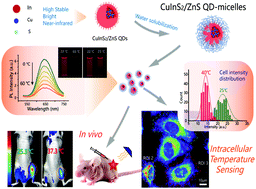Accurate intracellular and in vivo temperature sensing based on CuInS2/ZnS QD micelles†
Abstract
Accurate and sensitive temperature sensing is of great importance for studying biological activities in cells and tissues. Due to the complexity of the microenvironments, most of the existing thermometry systems cannot meet the needs of accurate intracellular and in vivo temperature sensing with high-sensitivity and low-toxicity. After investigation, we found that the fluorescence intensity of CuInS2/ZnS quantum dots (QDs) is significantly temperature dependent, and these QDs can be used for intracellular and in vivo temperature sensing after being encapsulated by amphiphilic micelles (QD-micelles). These QD-micelles have a size of approximately 10.1 ± 2.5 nm and an emission band of approximately 650 nm with intense photoluminescence (PL). Meanwhile, its high thermal sensitivity of 2% °C−1 at near-room temperature is insensitive to solution pH, ionic strength, and protein concentration. Even at a concentration of 300 μg mL−1, our QD-micelles do not exert cytotoxic effects on HeLa and PC-3 cells. Similar to being dispersed in water, the QD-micelles continue to exhibit a high thermal sensitivity of 2.0% °C−1 intracellular and 2.1% °C−1 in tumor tissues, and the PL intensity (I) and temperature (T) over the physiological temperature range have a good linear correlation. Therefore, they have considerable potential in biomedical applications.



 Please wait while we load your content...
Please wait while we load your content...